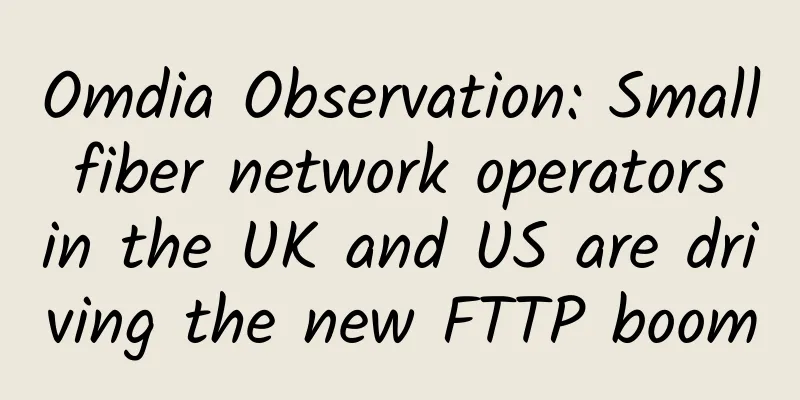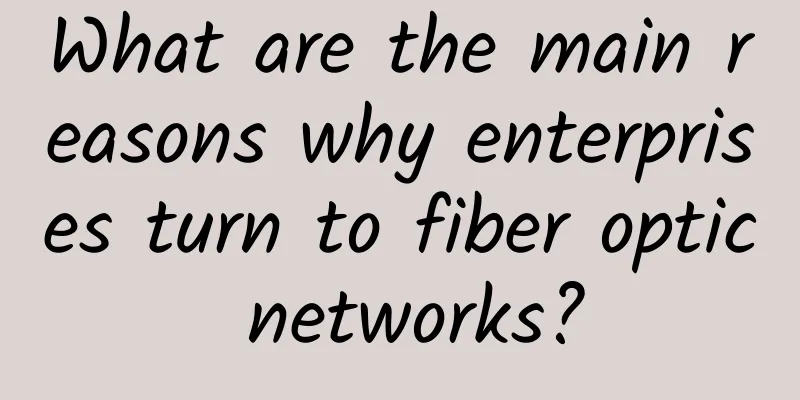Omdia Observation: Small fiber network operators in the UK and US are driving the new FTTP boom

|
The latest report from market research firm Omida shows that some UK and US households are benefiting from FTTP broadband services provided by small operators (rather than established telecom operators or cable TV operators). Many of these small operators are private companies that are not under pressure to disclose quarterly earnings. They are expanding their optical distribution networks (ODNs) and rely on some suppliers for PON equipment.
Smaller operators have advantagesThere are many non-incumbent operators in the UK and the US, including UK AltNets (such as CityFibre and Hyperoptic), as well as US WISPs and rural electric utilities. According to the UK Independent Network Cooperation Association INCA, more than $10 billion of private capital has flowed into UK AltNets, with billions more planned to flow in. In the US, many WISPs are expanding to FTTP due to spectrum limitations and continued growth in broadband demand. There are many operators in the US that focus on regional and urban fiber, for example, Brigham.net, LUS Fiber and Yomura Fiber are providing 10G services to US homes. The power of being private - Many of these small operators are privately held and are not in the public eye when it comes to quarterly reports on subscriber targets and profitability. While they are also working to achieve investor ROI targets, these are long term and often the optical distribution network itself is viewed as a valuable asset, similar to a land grab mentality. Power of selection – Non-incumbent operators can more easily select cities, neighborhoods, and even buildings to build fiber networks. Omdia highlighted this strategy with Google Fiber, and it is continuing with UK AltNets and smaller operators in the US. They can focus on residents who are underserved but may have higher ARPU. Virtually no integration nightmares – Many smaller fiber-based operators are new entrants into broadband access, and therefore, do not have the nightmare of integrating OSS/BSS with older copper- or coax-based technologies. Many small operators select only one vendor to provide PON equipment, eliminating the need for vendor interoperability. Small operators are influencing the ecosystemJulie Kunstler, senior principal analyst for broadband access at Omdia, said that established operators have noticed these smaller fiber access network operators, but large telecom operators have been focusing on the deployment of 5G wireless networks. In the US market, large cable TV operators have begun to get involved in FTTP, but the pace is very slow. Moreover, established operators can easily ignore the number of FTTP users below 1 million because these users are insignificant in terms of investor scrutiny. However, telecoms and cable operators will have a hard time winning back these types of users, even with their own FTTP service offerings. From a user’s perspective, why change from one fiber service to another unless it’s due to poor quality or a significant price advantage? We can imagine consolidation between the many AltNets in the UK, or even their acquisition by Openreach. In the US, acquisitions of smaller operators by large cable operators are likely, but there may be overlap in coverage – albeit over coax networks, which may be difficult to justify to investors. For providers, these smaller operators often require different solutions and support services than the established operators. First, they want networks that are easy to expand, upgrade, and operate because their teams are very lean; they don't have a large network operations team. AltNets are looking for solutions that support seamless wholesaling to a wide range of retail operators. Small US operators are supporting residential and business services on the same optical distribution network without having to deal with the challenges of multi-department coordination. Some providers, taking advantage of the new FTTP boom, have established sales and support teams focused on meeting the needs of these small operators. |
<<: What will happen when 5G network falls in love with public cloud?
Recommend
After 2G network withdrawal, the results began to show
After a short period of stagnation, telecom busin...
Friendhosting Christmas/New Year promotion, 40% off all VPS hosts, unlimited traffic in multiple computer rooms
Friendhosting launched a promotion for Christmas ...
Network Address Translation Protocol (NAT) and Its Application Examples
1. The meaning of NAT When some hosts within a pr...
My girlfriend suddenly asked me what DNS is...
[[357457]] This article is reprinted from the WeC...
Out-of-the-box infrastructure connectivity options
When it comes to connecting network devices acros...
Exploring the evolution of Ethernet bandwidth for 5G bearer
From the voice services in the 2G era, to the ris...
Comparative Analysis of Kubernetes Network Plugins (Flannel, Calico, Weave)
[[269494]] This article will focus on exploring a...
The three major operators earn 400 million yuan a day? ! China Mobile + China Telecom + China Unicom + China Tower < Tencent
Recently, the three major operators have successi...
2G network withdrawal has 200 million potential users, elderly mobile phones have pain points and no market
[[343834]] I have tried According to statistics f...
Goodbye, 2G/3G is retiring
With the advent of the 5G era, there have been a ...
MEC – Are we getting closer?!
Multi-access edge computing (MEC) or previously m...
Fiber Polarity and Its Role in Switching Technology
Before we delve into the world of switching techn...
Application of IoT technology in the logistics industry under the background of 5G
The Internet of Things has the characteristics of...
[Python Flask Practice] Get HTTP request data
[[389990]] When the client accesses the server pr...
E-Dianbao CEO Rulai Chen Tao tells you that the reason behind being No.1 is that he has been focusing on one thing for 13 years
[51CTO.com original article] The interview with C...


![[Black Friday] RAKsmart: VPS flash sale from $0.99/month, cloud server flash sale from $1.99/month, dedicated server flash sale from $30/month](/upload/images/67cabced032b3.webp)






